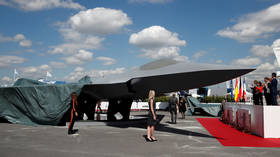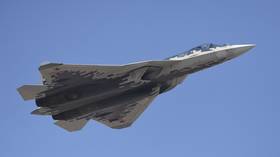Mockup of a dream: Europe eyes 6th-generation fighter jet of its own, but will it happen?

European countries are striving to develop a next-generation aircraft that is fully independent from the US. While the desire is understandable, many doubt their capability to do so.
This week, Germany and France unveiled a mockup of an upcoming jointly-developed 6th-generation fighter jet during the Paris Air Show, while Spain announced it had joined the project. The program to create the aircraft, dubbed New Generation Fighter (NGF), was launched back in 2017, and the machine is still at a very early stage of development; the mockup indeed resembles a plane, yet it lacks a chassis, resting on a pedestal of sorts instead.
The development of the aircraft is expected to take over 20 years, while the first flight is supposed to happen by the late 2020s. The aircraft is to be introduced in 2040.
The NGF is not the only 6th-gen fighter in development by European countries. Last year, the UK unveiled a concept of its own, BAE Systems’ Tempest. The launch of the British program was largely the result of the ongoing divisions in Europe with Brexit looming and the fact that the UK was not taken into the joint French-German program.
While the mockup of the British plane appears to be more detailed than the NGF, it is not expected to be fleshed out anytime soon. Its first flight is also expected to happen by the late 2020s, with Britain claiming it will be in service by 2035.
While the Tempest belongs in the same distant future as the NGF, France and Germany are not very happy with the competition and are not even trying to hide it.
“Competition amongst Europeans when it weakens us against the Americans, the Chinese, is ridiculous,” French President Emmanuel Macron told reporters while presenting the NGF mockup.
What is a 6th-gen fighter exactly?
For now, 6th-gen fighter jets are a purely conceptualized class; there are no real planes of this type and several machines expected to be in this category are at the very early stages of development.
Moreover, 5th-gen fighters are still uncommon – Russia and China have produced a limited number of Su-57s and J20s respectively – and the only nation producing such machines in significant numbers is the US.
“There is no consensus on what exactly the 6th-generation combat aircraft will be and how it will differ from the 5th-gen,” drone warfare expert Denis Fedutinov told RT.
The capabilities of the 6th-gen aircraft, vaguely described by the developers, should be taken with a grain of salt, since they’re not real characteristics but mere intentions. The German-French-Spanish planes are expected to be capable of operating together with drones, sharing data between each other within an “air combat cloud,” feature artificial intelligence, and so on. The UK competitor appears to be even more impressive, as its developers expect to produce an altogether pilotless version of the plane, fitted with some kind of “energy weapons.”
Advertising aside, the 6th-gen is expected to feature more advanced “electronic warfare, sophisticated computer processing & algorithms, and increased autonomy,” as well as being capable of using supersonic weaponry, Elmar Giemulla, a leading expert on air and traffic law at Berlin University of Technology’s Institute of Aeronautics and Astronautics, told RT.
Why do Europeans need it at all?
The desire to be independent from the US and its F-35s – as well as expanding export capabilities – are believed to be the main drivers in the European quest to design a 6th-gen fighter. The Europeans’ capability of making a new plane truly independently, however, is doubtful, since key technology for such a sophisticated machine would actually come from the US, Michael Maloof, a former senior security policy analyst at the Pentagon, told RT.
A lot of technologies that would go into making that aircraft would require US approval.
The 6-th gens are likely to show even deeper integration between each other and other weapon systems and hardware, a feature already possessed by the 5th-gens, namely the F-35s, he added.
Also on rt.com ‘NATO solidarity clause is called Article 5, not article F-35’ – French defense ministerSuch interconnectivity might actually be one of the reasons Europe wants a similar plane – but of its own design, military expert Mikhail Khodarenok believes. Apart from the obvious convenience, such sophistication might actually pose a threat for end users outside the US. While in the past Washington was able to severely limit capabilities of foreign users of its weaponry through tricky end-user agreements, integration has opened up new possibilities for that.
“There’s only one global center, the so-called Autonomic Logistics Operating Unit (ALOU), that makes lists of spare parts and conducts distribution to the users of F-35,” Khodarenok said, adding that the system is “genius,” as it effectively allows control of every F-35 customer “regardless of where the machine is, and limit its combat capabilities if needed.”
Do Europeans have what it takes to create a 6th-gen plane?
European countries have decided to skip development of a 5th-generation fighter jet altogether and instead stick to upgrading older machines or purchase US-made F-35s instead. Bridging such a technological gap is a very difficult task, and there are serious doubts over whether the Europeans could manage to do it alone or at all, Fedutinov warned.
The process of development of aviation technology is progressive in nature; it is almost impossible for an industry to jump over a generation and create an airplane of the 6th generation without creating the 5th before.
Khodarenok, on the contrary, believes the Europeans have “enough experience in all the spheres of aircraft building to create a perspective machine.” At the moment, it’s too early to tell whether they could actually manage to pull it off and we’ll need to wait until 2040 to see if it becomes a reality, he said.
“It’s quite hard to tell anything concrete about the European design. It’ll likely be possible to tell something real and tangible about the French-German-Spanish fighter jet not earlier than in 2040 – whether it succeeded or not,” Khodarenok said.
Also on rt.com Speed, performance, privacy & pain: But Pentagon says F-35 issues have ‘acceptable workarounds’Subscribe to RT newsletter to get stories the mainstream media won’t tell you.
















